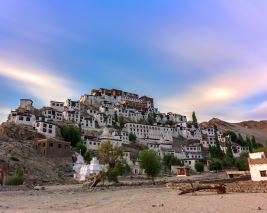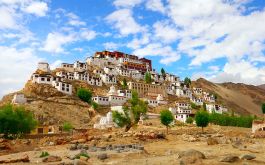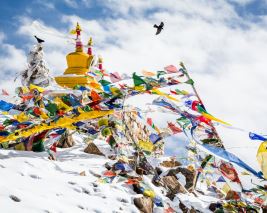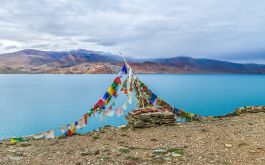The majestic heights of Ladakh
If you dream of discovering the untouched grandeur of the mountains, Ladakh tourism packages are your answer. Picture yourself biking through breathtaking mountain passes, camping by Pangong Lake, or immersing yourself in the serenity of monasteries—sounds like a fantasy, doesn't it? Well, now it's more accessible than ever, thanks to a variety of Leh Ladakh package deals to suit different budgets and preferences for Leh tourism.
Whether you are interested in a group tour where everything is done for you or a customised Ladakh tourism packages that leaves you with a little more room to roam, there's a Leh Ladakh trip package that has your name on it. Most Leh Ladakh travel packages range from ₹31,000 upwards based on duration and places visited. You have choices ranging from short 5-day trips to detailed 10-day trips to Leh, Nubra Valley, Pangong, Hanle, and even Kargil.
The most sought-after Ladakh trip package is the 7-day Magical Ladakh tour of Leh, Nubra, and Pangong, which is ideal if this is your first time visiting. Should you desire greater specificity, there's the Exotic Ladakh with Kashmir tour of Leh and Srinagar. Rates are usually cut, and EMIs begin from as low as ₹1,800/month. So, price is no longer a matter! It's time to pack those bags and hit the road!
| Ladakh Tourism: A Quick View of the City |
| State |
Jammu and Kashmir |
| Official Language |
Hindi, English and Ladakhi (also called Bhoti or Bhodi) |
| Dial Code |
01982 |
| Population |
274,289 |
| Currency |
Indian Rupee (INR) |
| Time Zone |
GMT +5:30 (IST) |
| Area |
59,196 square kilometres |
Highlights: Monasteries and more
These Leh Ladakh travel package typically comprise flights, accommodations, meals, local sightseeing, and even a tour manager, making your Leh Ladakh package trouble-free. And loyalty points on reservations add a sweet treat for your next travel.
If you're the type who wants to see India's highest motorable passes and infinite mountain loveliness, do not tarry. Select the correct Leh and Ladakh package, pack your bags, and mark Ladakh off your travel wish list. With so many Leh Ladakh packages available, your adventure is just a click away.
Best time to visit Ladakh
If you're organising your fantasy holiday with Ladakh tour packages, timing is the key. Let me introduce you to the best months so that your experience is not only wonderful but also safe and hassle-free.
Best Time to Visit:
The best time to visit Ladakh in India from late April to mid-July. It is when the weather is the most pleasant, with day temperatures between 15°C to 25°C. Both the Srinagar-Leh and Manali-Leh roads are open, so your Ladakh trip package will have full circuit options. It is peak season for a reason—the mountains remain snow-covered, rivers are sparkling, and the air is fresh. Ideal for photography, bike rides, and sightseeing.
Off Season (November to March & July-August):
Severe cold in winter and heavy monsoon rains make this season challenging to travel. All routes shut down, and many hotels stay closed as well. Yet, some customised Leh Ladakh holiday packages suit snow enthusiasts and offbeat tourists.
Shoulder Season (Mid-September to October):
If you want a less crowded atmosphere with fewer people and Ladakh tourism prices being low, this is the best time. The weather is pleasant, and you'll mostly get discounts on Kashmir and Leh Ladakh package or any Ladakh trip package.
How to reach Ladakh?
Arriving in Ladakh is half the fun, and it's worth every penny. When you plan your Ladakh tourism packages, here's how to reach Ladakh to this enchanting land:
By train
There is no direct train to Ladakh. Take a train to Jammu Tawi or Srinagar, then hop into a taxi or bus. It's a picturesque ride and slots well into the Ladakh tourism cost budgets.
By Road
To experience it all, drive up from Manali or Srinagar. This route is best suited for a personalised Leh Ladakh package or an adventure Leh Ladakh travel package, enhancing tourism in the region with stunning mountain scenery.
By Air
The most convenient method is by flying to Leh's Kushok Bakula Rimpochee Airport, well-linked with Delhi, Mumbai, and beyond. It's ideal if you need to save time and jump right into your Ladakh tourism packages.
No matter what you choose, your Leh Ladakh holiday packages will be something memorable.
Best Places to Visit in Ladakh
If you are planning to travel and research Ladakh tourism packages, here's a quick guide for you. Ladakh, located in the northernmost region of India, is not just a destination—it's an experience, a feeling that lingers with you. Whether you are considering Leh Ladakh and Kashmir tour packages or researching customised Ladakh travel packages, this destination will capture your heart.
Famous Places to Visit
Tso Moriri:
A quieter, lesser-known sibling of Pangong, this lake is sheer tranquility.
Zanskar Valley:
Isolated, rugged and unbelievably picturesque—ideal for photography and quiet contemplation.
Magnetic Hill:
An optical illusion that will blow your mind—your car will appear to be rolling up a hill while the road is actually going downhill!
Pangong Tso Lake:
A postcard-perfect body of water that shifts colour with the heavens—this is usually the epitome of the majority of Ladakh tourism itineraries.
Khardung La Pass:
One of the highest motorable roads in the world—perfect for adventure lovers.
Nubra Valley:
With the double-humped camels, sand dunes and monasteries, this desert valley shocks every visitor.
Beaches/ Hill Stations to Visit
Ladakh lacks the usual hill stations, but its valleys are heavenly. The Markha Valley Trek cannot be missed if you love adventure. With Ladakh India tourism, you find high-altitude beauty unmatched in the world.
Temples to Visit
Gurdwara Pathar Sahib:
A serene Sikh temple with terrific tales and complimentary chai!
Thiksey Monastery & Hemis Monastery:
These are big religious centers and leading choices in Leh Ladakh travel package.
Alchi Temple, Red Maitreya Temple, and Matho Temple:
These provide an insider's look into Buddhist heritage.
Though Ladakh tourism cost can vary, there are budget-friendly Leh Ladakh tour packages out there. Look into flexible Ladakh travel packages that include both spiritual and scenic stops. Trust me, with the right plan, you’ll never want to leave.
Food to Eat in Ladakh
If you’re planning your Leh Ladakh trip package, food in Ladakh is more than just a meal. It’s like taking a bite out of the region’s culture, its people, and its stories. With most Ladakh tourism packages, you’ll come across local eateries or homestays offering these authentic dishes. And here’s the best part—you don’t have to look far. Let me guide you through the delicacies that you ought to try and where you can do so during your next Leh and Ladakh package.
Momos:
Available everywhere in Leh Market, particularly at restaurants like The Tibetan Kitchen, they taste best with spicy chutney.
Skyu:
Piled high, hot and tasty, best ordered at Lamayuru Restaurant adjacent to Shanti Stupa.
Chhutagi:
Great to have after trekking! Chhutagi is a must at most homestays of villages, so consider taking a Ladakh trip package that includes village stays.
Thukpa:
Eat this hot noodle soup at Gesmo Restaurant. It's soothing after a tiring day of sightseeing.
Tingmo:
Soft buns, preferably with curries, are available at Bon Appétit café.
Khambir & Apricot Jam:
Do not miss having breakfast at a nearby bakery close to Main Bazaar if your Ladakh tourism packages schedule begins early.
Butter Tea & Chhang:
Provided in most of the homestays or as a festival gift—usual add-ons in Leh Ladakh package tours.
Chhurpe:
This dry yak cheese will be available at home or local small grocery stores—take some back with your Ladakh travel packages!
Including food explorations in your Leh tourism package not only keeps your tummy full but also allows you to connect more with the location. Whether you explore through Ladakh holiday packages, Ladakh India tourism, or personalised Ladakh tourism packages, ensure your plate is as full of experiences as your heart. Explore Ladakh Bike Trip packages with Thomas Cook.
And yes, while reviewing the Leh tourism package cost, keep in mind that most meals here are affordable but unforgettable. That's the charm of a well-planned Leh Ladakh travel package—flavour, culture, and adventure, all packaged together.
People also ask about Ladakh
1. What’s not included in a typical Leh Ladakh holiday packages?
Meals outside Leh, monastery entry fees, camera charges, and tips are generally not included. So always request a clear itinerary and cost breakdown. It helps determine your overall Leh tourism cost.
2. How much flexibility can Ladakh holiday packages have?
Much more than you'd imagine. You can customise routes, infuse a hint of Kashmir through Leh Ladakh and Kashmir tour packages, or even combine it with cultural stays. Flexibility is subject, to some extent, to the cost of Leh tourism and the agency you plan to use.
3. Are Inner Line permits a part of the Leh Ladakh travel package?
Inner line permits need to be bought if you plan to visit Nubra, Pangong, Tso Moriri, etc. Most of the best Leh and Ladakh packages take care of this for you, so double-check in advance.
4. Which route is best for a Ladakh bike trip – Srinagar or Manali?
Both Srinagar–Leh and Manali–Leh routes offer stunning views and unique experiences, but each has its own pros:
- Srinagar to Leh Route is ideal for beginners as it allows gradual acclimatization to high altitude. The route is scenic, with stops at Sonamarg, Drass, and Kargil, and is generally smoother and less challenging.
- Manali to Leh Route is more adventurous and popular among experienced riders. It features challenging passes like Rohtang La, Baralacha La, and Tanglang La, making it perfect for thrill-seekers.
If you're looking for a Ladakh Bike Tour Packages and easier start, go via Srinagar and return via Manali for the complete Ladakh bike circuit experience.




























































